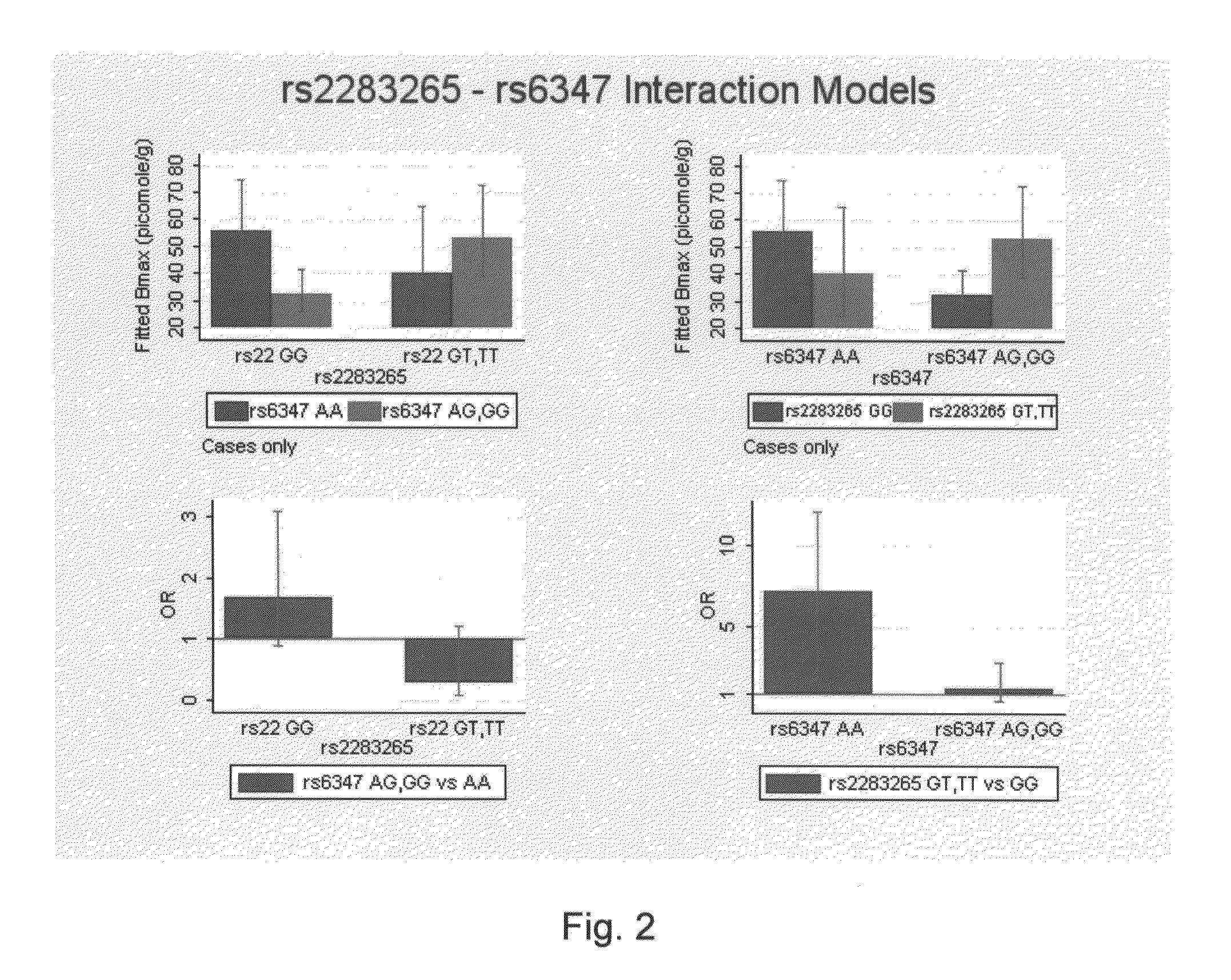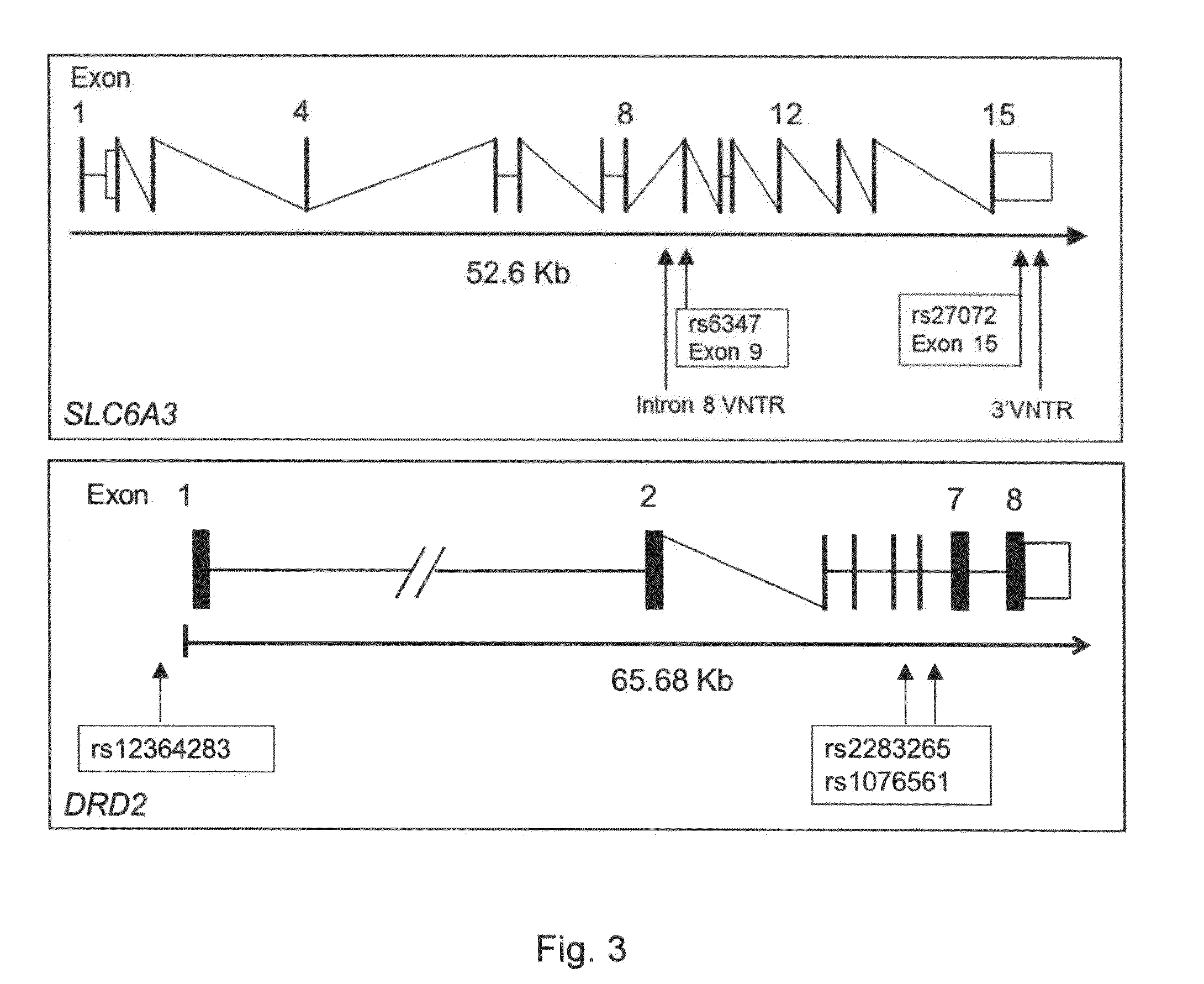Materials and Methods Related to Dopamine Dysregulation Disorders
a technology of dopamine dysregulation and materials, applied in the field of dopamine dysregulation disorders, can solve the problems of substantial increase in the risk of cocaine abuse and overdose, and achieve the effects of strong gene-gene- and haplotype-environment effects, low risk, and high ors
- Summary
- Abstract
- Description
- Claims
- Application Information
AI Technical Summary
Benefits of technology
Problems solved by technology
Method used
Image
Examples
example 1
General Experimental Procedures
[0220]Postmortem Human Brain Tissues from the Miami Dowd County Brain Endowment Bank.
[0221]Prefrontal cortex (PFC) (Brodmann's area 46) and / or putamen tissue samples from cocaine abusers who died from cocaine intoxication and age-matched drug-free controls were provided by the Miami Brain Endowment Bank (University of Miami, Miami, Fla.). In this study, a total of 225 subjects were studied (126 cases (cocaine overdose deaths), 99 controls (non-drug related death)). Each group contained 86% males, 14% females; with the average age of 36 for the controls and 37 for the cases. Whites (Caucasians and Hispanics) accounted for ˜64% and non-whites for ˜36% (African Americans). Brain and blood toxicology and neuropathologic evaluations were available for each case, and most of the drug-exposure cases obtained at autopsy came from individuals who had evidence of a number of surrogate measures of chronic cocaine abuse (drug-related pathology, arrest records, and...
example 2
Single Variant Case-Control Associations
[0234]The inventors genotyped three DRD2 and four DAT variants in the Miami Cohort of 126 cases (cocaine overdose) and 99 controls (Table 1). Among these, rs1076560 and rs2283265 affect splicing of D2 mRNA, and rs1264283 increases transcription of DRD2. For DAT variants, the strongest evidence for functional relevance in vivo rests with the 3′UTR rs27072 and with rs3836790, here referred to as intron8 5 / 6-repeat, while an effect of rs6347 cannot be excluded. Allele frequencies in cases and controls are provided in Table 7, and LD values and MAF are in Table 8. Each of these variants was analyzed for a possible association with cocaine overdose, using 4 different genetic models (Table 2). Dominant and additive models gave significant association, while recessive and independent genotype models yielded less significant or no associations. The dominant model was adopted to accommodate less frequent variants for further analysis.
[0235]Both rs10765...
example 3
2-Variant Interaction Models
[0238]Estimating the combined effects and interactions of DRD2 rs2283265 and DATintron8 5 / 6-repeat, the inventors established a significant interaction. The interaction model yielded a significant improvement over the main effect only models (LRT p-value 0.006) and was significantly better than the naïve model (p-value 0.001). To illustrate the impact of this interaction, by considering only the DRD2 SNP rs2283265 (ignoring DAT), subjects carrying the minor T allele have 2.3 times the odds of cocaine overdose than homozygous GG carriers (p=0.015; all subjects). Examining the fitted values from rs2283265 versus intron8 5 / 6-repeat interaction model reveals that the odds ratio of cocaine overdose associated with rs2283265 varies strongly with intron8 genotype. In carriers homozygous for the main intron8 6-repeat allele of DAT, the DRD2 rs2283265 OR increases to 7.6 (p-value 0.001) (Table 3). Conversely, in the presence of the intron8 5-repeat allele, the odd...
PUM
| Property | Measurement | Unit |
|---|---|---|
| temperatures | aaaaa | aaaaa |
| temperatures | aaaaa | aaaaa |
| temperatures | aaaaa | aaaaa |
Abstract
Description
Claims
Application Information
 Login to View More
Login to View More - R&D
- Intellectual Property
- Life Sciences
- Materials
- Tech Scout
- Unparalleled Data Quality
- Higher Quality Content
- 60% Fewer Hallucinations
Browse by: Latest US Patents, China's latest patents, Technical Efficacy Thesaurus, Application Domain, Technology Topic, Popular Technical Reports.
© 2025 PatSnap. All rights reserved.Legal|Privacy policy|Modern Slavery Act Transparency Statement|Sitemap|About US| Contact US: help@patsnap.com



